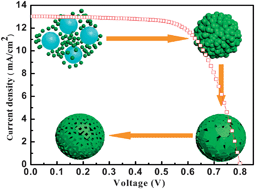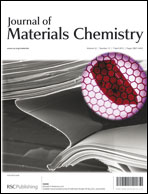Hollow anatase TiO2 porous microspheres with V-shaped channels and exposed (101) facets: Anisotropic etching and photovoltaic properties†
Abstract
Owing to the excellent physical and chemical properties for potential application in multiple fields, design and synthesis of semiconductor titanium dioxide with tailor-made crystal facets and V-shaped porous sturcuctures have attracted great research interest. In this work, we prepared hollow anatase TiO2 microspheres (HTS) with exposed (101) facets and V-shaped channels via a novel anisotropic etching method. The obtained HTS microspheres are constructed by two layers, the inner layer is TiO2 nanoparticles, while the outer layer is composed of single-crystal TiO2 nanosheets with highly exposed (101) facets and V-shaped channels. The cooperative effect of hydrogen peroxide with ammonium fluoride and an anisotropic corrosion process are proposed to understand the formation mechanism. Hydrogen peroxide decomposed to form O2 bubbles, which acted as templates for the formation of TiO2 microspheres with cavities. Fluorine ions were able to promote the formation of anatase (001) facets at the beginning of the reaction and then etch the (001) facets with the reaction progress, leaving highly exposed (101) facets and V-shaped channels along the [001] direction. Due to the unique structure of anatase TiO2 (101) single crystal nanosheets and the strong light scattering effects from the V-shaped channels, the dye-sensitized solar cells (DSSCs) based on our HTS sample have a high open voltage of 0.9 V. The optimized DSSC based on our HTS sample showed an overall light-electron conversion efficiency of 7.05% with a lower dye absorption.


 Please wait while we load your content...
Please wait while we load your content...